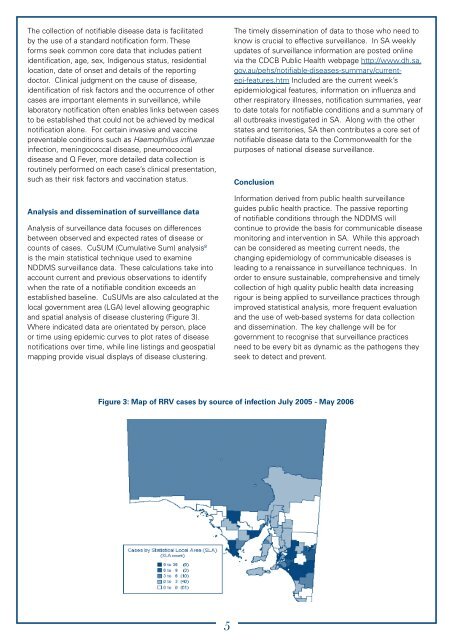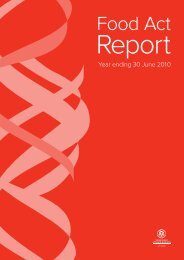Public Health and Communicable Diseases - SA Health - SA.Gov.au
Public Health and Communicable Diseases - SA Health - SA.Gov.au
Public Health and Communicable Diseases - SA Health - SA.Gov.au
You also want an ePaper? Increase the reach of your titles
YUMPU automatically turns print PDFs into web optimized ePapers that Google loves.
The collection of notifiable disease data is facilitatedby the use of a st<strong>and</strong>ard notification form. Theseforms seek common core data that includes patientidentification, age, sex, Indigenous status, residentiallocation, date of onset <strong>and</strong> details of the reportingdoctor. Clinical judgment on the c<strong>au</strong>se of disease,identification of risk factors <strong>and</strong> the occurrence of othercases are important elements in surveillance, whilelaboratory notification often enables links between casesto be established that could not be achieved by medicalnotification alone. For certain invasive <strong>and</strong> vaccinepreventable conditions such as Haemophilus influenzaeinfection, meningococcal disease, pneumococcaldisease <strong>and</strong> Q Fever, more detailed data collection isroutinely performed on each case’s clinical presentation,such as their risk factors <strong>and</strong> vaccination status.Analysis <strong>and</strong> dissemination of surveillance dataAnalysis of surveillance data focuses on differencesbetween observed <strong>and</strong> expected rates of disease orcounts of cases. CuSUM (Cumulative Sum) analysis 8is the main statistical technique used to examineNDDMS surveillance data. These calculations take intoaccount current <strong>and</strong> previous observations to identifywhen the rate of a notifiable condition exceeds anestablished baseline. CuSUMs are also calculated at thelocal government area (LGA) level allowing geographic<strong>and</strong> spatial analysis of disease clustering (Figure 3).Where indicated data are orientated by person, placeor time using epidemic curves to plot rates of diseasenotifications over time, while line listings <strong>and</strong> geospatialmapping provide visual displays of disease clustering.The timely dissemination of data to those who need toknow is crucial to effective surveillance. In <strong>SA</strong> weeklyupdates of surveillance information are posted onlinevia the CDCB <strong>Public</strong> <strong>Health</strong> webpage http://www.dh.sa.gov.<strong>au</strong>/pehs/notifiable-diseases-summary/currentepi-features.htmIncluded are the current week’sepidemiological features, information on influenza <strong>and</strong>other respiratory illnesses, notification summaries, yearto date totals for notifiable conditions <strong>and</strong> a summary ofall outbreaks investigated in <strong>SA</strong>. Along with the otherstates <strong>and</strong> territories, <strong>SA</strong> then contributes a core set ofnotifiable disease data to the Commonwealth for thepurposes of national disease surveillance.ConclusionInformation derived from public health surveillanceguides public health practice. The passive reportingof notifiable conditions through the NDDMS willcontinue to provide the basis for communicable diseasemonitoring <strong>and</strong> intervention in <strong>SA</strong>. While this approachcan be considered as meeting current needs, thechanging epidemiology of communicable diseases isleading to a renaissance in surveillance techniques. Inorder to ensure sustainable, comprehensive <strong>and</strong> timelycollection of high quality public health data increasingrigour is being applied to surveillance practices throughimproved statistical analysis, more frequent evaluation<strong>and</strong> the use of web-based systems for data collection<strong>and</strong> dissemination. The key challenge will be forgovernment to recognise that surveillance practicesneed to be every bit as dynamic as the pathogens theyseek to detect <strong>and</strong> prevent.Figure 3: Map of RRV cases by source of infection July 2005 - May 2006
















